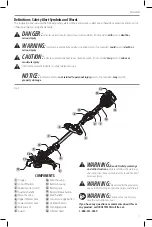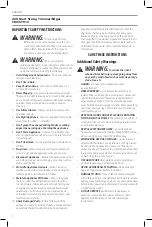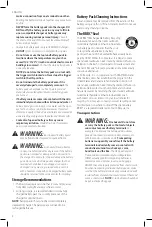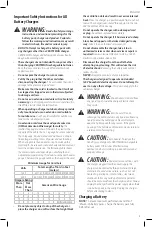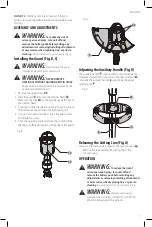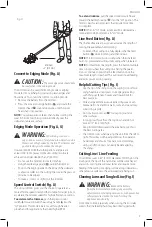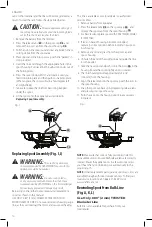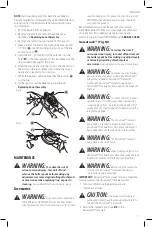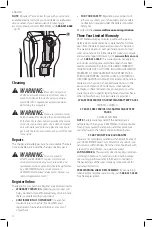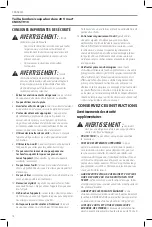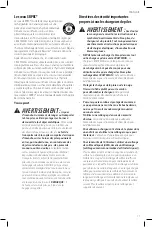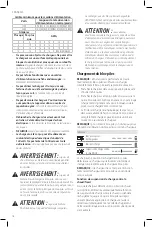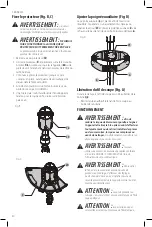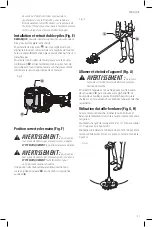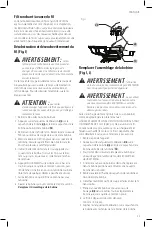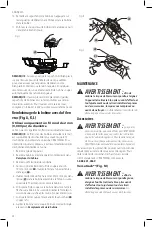
9
English
Fig. H
Minimum
24" (610 mm)
Convert to Edging Mode (Fig. A)
CAUTION:
The wire edge guide should only
be used when in the edging mode.
The trimmer can be used in trimming mode or edging
mode to trim overhanging grass along lawn edges and
flower beds. To convert the trimmer to edging mode:
1. Remove the battery from the trimmer.
2. Press the convert-to-edge button
15
and rotate the
trimmer head
18
counterclockwise, until the spool
head snaps into position.
nOTE:
You will experience faster than normal cutting line
wear if the trimmer line is positioned directly over the
sidewalk or abrasive surface.
Edging Mode Operation (Fig. A, G)
WARNING:
When being used as an
edger, stones, pieces of metal and other objects can be
thrown out at high speed by the line. The trimmer and
guard are designed to reduce the danger.
However, MAKE SURE that other persons and pets are
at least 100' (30 m) away. Optimum cutting results are
achieved on edges deeper than 2" (50 mm).
• Do not use this trimmer to create trenches.
• Using the wire edge guide
17
, guide the trimmer.
• Position the edging guide on the edge of the sidewalk
or abrasive surface so the cutting line is over the grass or
dirt area to be edged.
• To make a closer cut, slightly tilt the trimmer.
Speed Control Switch (Fig. A)
This string trimmer gives you the choice to operate at a
more efficient speed to extend the runtime for larger jobs, or
accelerate the trimmer speed for high-performance cutting.
To accelerate the trimmer,
push the speed control
switch
3
forward toward the auxillary handle
4
into the
"HI" position. This mode is best to cut through heavier
growth and for applications that need higher RPM.
To extend runtime
, pull the speed control switch back
toward the battery housing
11
into the "LO" position. This
mode is best for larger projects that require more time
to complete.
nOTE:
When in "HI" mode, runtime will be decreased as
compared to when trimmer is in "LO" mode.
Line Feed Button (Fig. A)
The line feed feature allows you to advance the length of
cutting line available while trimming.
• To extend the cutting line, fully depress the line feed
button
16
while trimming and then release.
nOTE:
The trimmer will stop cutting when the line feed
button is pressed and will resume cutting when released.
nOTE:
For maximum line length, press the button multiple
times until you hear the cutting line hitting the guard.
Do not continue to press the line feed button once the
maximum length is reached. This will result in overfeeding
and will consume string quickly.
Helpful Cutting Tips (Fig. I)
• Use the tip of the string to do the cutting; do not force
string head into uncut grass. Use edge guide along
such things as fences, houses and flower beds for
best practices.
• Wire and picket fences cause extra string wear, even
breakage. Stone and brick walls, curbs, and wood may
wear string rapidly.
• Do not allow spool cap
23
to drag on ground or
other surfaces.
• In long growth, cut from the top down and do not
exceed 13" (330 mm) high.
• Keep trimmer tilted toward the area being cut; this is
the best cutting area.
• The trimmer cuts when passing the unit from the left to
right. This will avoid throwing debris at the operator.
• Avoid trees and shrubs. Tree bark, wood moldings,
siding, and fence posts can easily be damaged by
the string.
Cutting Line / Line Feeding
Your trimmer uses .080" (2 mm) diameter, TWIST nylon line.
During use, the tips of the nylon lines will become frayed
and worn. Cutting line will wear faster and require more
feeding if the cutting or edging is done along sidewalks or
other abrasive surfaces or heavier weeds are being cut.
Clearing Jams and Tangled Line (Fig. I)
WARNING:
Remove the battery
from the trimmer before making any assembly,
adjustments or changing accessories. Such preventive
safety measures reduce the risk of starting the
appliance accidentally.
From time to time, especially when cutting thick or stalky
weeds, the line feeding hub may become clogged with



